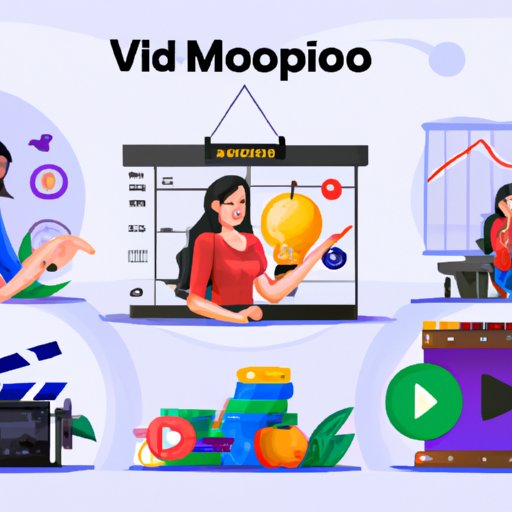
Introduction
Have you ever wanted to make a video but didn’t know where to start? With the advent of smartphones and affordable video editing software, making videos has never been easier. In this article, we will break down the video-making process into clear steps and provide tips and tricks to create a polished final product.
Breaking it down into clear steps
The key to making a great video is to have a plan and stick to it. Here are the basic steps to make a video:
Choosing a subject
Before starting, you should decide on a subject for your video. It could be a person, place, or thing. Think about what story you want your video to tell and what kind of message you want to convey.
Preparation and planning
Once you have a subject, it is time to start preparing for the shoot. This involves things like scouting locations, preparing a shot list, and gathering equipment. A shot list is a detailed plan of all the shots you need to capture to tell your story. It helps ensure that nothing is missed during the shoot.
Filming footage
Now that you have a plan, it is time to start filming. It is recommended that you use a tripod to keep the camera steady and avoid shaky shots. Additionally, it is important to capture plenty of footage. The more footage you have, the easier it will be to cut together a polished final product.
Editing the final product
Once you have captured all the necessary footage, it is time to start editing. Video editing software such as Adobe Premiere Pro and Final Cut Pro X can be used to cut together footage, add effects, and transitions. The editing process can be time-consuming, but it is essential to produce a polished final product.
Focusing on specific software
For beginners, it can be helpful to focus on easy-to-use video editing software. Here is a step-by-step guide on how to use iMovie, which is a free video editing software for Mac users:
Step 1: Import footage
Open iMovie and import all the footage you want to use.
Step 2: Create a new project
Click on ‘New Project’ and then select the aspect ratio you want to use.
Step 3: Add footage to your timeline
Drag and drop the footage you want to use into the timeline. You can then trim the footage by dragging the edges of the clip.
Step 4: Add transitions and text
Navigate to the ‘Transitions’ and ‘Titles’ tabs to add professional-looking transitions and text to your video.
Step 5: Export your video
Once you are happy with your video, you can export it by clicking on ‘File’ and then ‘Share’.
Using examples
One of the best ways to learn how to make a great video is to study successful videos and techniques.
Example 1: How-to Videos
The YouTube channel ‘How To Cake It’ is a great example of how-to videos done right. The host, Yolanda Gampp, provides detailed instructions and tips on how to make creative cakes. By breaking down complex designs into easy-to-follow steps, Gampp provides value to her audience while keeping them entertained.
Example 2: Promotional Videos
In 2019, Apple released a promotional video for its new iPhone 11 Pro. The video showcases the phone’s new triple-camera system by using stunning visuals and a powerful score. By using creative camera angles and impressive visuals, the video manages to make a standard product video into a work of art.
Example 3: Informational Videos
‘Kurzgesagt – In a Nutshell’ is a YouTube channel that creates animated informational videos on a wide range of topics. By using captivating animations and simplifying complex topics, the channel manages to educate its audience while keeping them engaged.
Considering different video types
Depending on what kind of video you want to make, there are certain things to consider.
How-to Videos
When creating instructional videos, it is important to break down complex tasks into simple steps. Focus on the details and include tips for success. It can also be helpful to show multiple angles and use clear, concise language.
Promotional Videos
When creating a promotional video, it is important to make your product or service stand out. Use creative camera movements and show the product in use. Consider using a voiceover or background music to create an emotional connection with viewers.
Informational Videos
When creating informational videos, it is important to make complex topics easy to understand. Use clear visuals and break down complex concepts into simple terms. Consider using humor or storytelling to keep viewers engaged.
Using visuals
Using visuals can be helpful to show readers what their final product should look like and to illustrate certain parts of the process. Below are some examples of visuals:
Screenshots
Adding screenshots can be helpful to show users what their video should look like at each step of the process.
Video Clips
Adding video clips can be helpful to illustrate certain parts of the editing process, such as cutting together footage or adding transitions.
Providing best practices
Here are some tips to help readers make the best video possible:
Keep the video short and to the point
Attention spans are short, so aim to keep your video under three minutes.
Use good quality equipment
To create a professional-looking video, it is important to use good quality equipment. This includes a camera, tripod, and microphone.
Tell a story in the video
By telling a story, you can create an emotional connection with viewers and make your video more memorable.
Conclusion
Creating a video can be a fun and rewarding experience. By following the steps in this guide and experimenting with different techniques, you can create a polished video that tells a great story. Don’t be afraid to get creative and experiment with different ideas. With practice, you can become a master video-maker.





